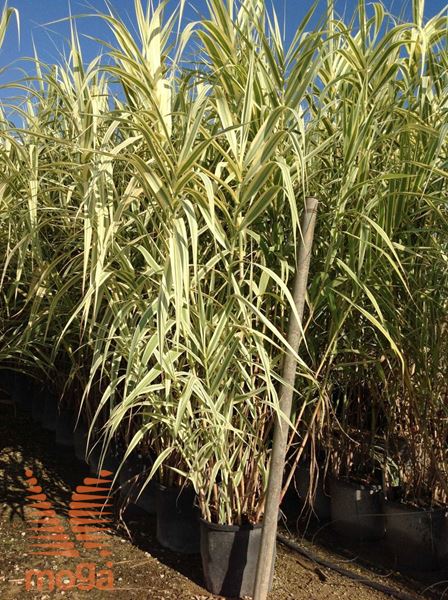Arundo donax "Variegata"
Arundo donax versicolor
navadna kanela "Aureovariegata"
navadna trstenika "Aureovariegata"
-
These plants grow well in sun or in partial shade. Usually they tolerate more sun and heat if given enough moisture; in partial or light shade they need less moisture.
-
Herbaceous plants are not woody. Their stems are soft, usually remaining green. With some herabceous older stems may harden and look like woody stems (e. g. bamboo).
-
Leaves or needles remain on the plant throughout the winter and fall down in spring when new ones emerge. Part of leaves or needles may fall already in autumn or winter. The falling off depends on winter temperature, so some plants are evergreen in mild winter, yet decidous in cold winter
-
Plant can in otherwise appropriate environment survive cold down to - 23 °C.
-
Moist soil usually contain morefine clay parts and less sand, more humus and organic materials, they are somewhat heavier, but not hard; water does not run away quickly but stays among soil particles and is long available to plants. There is no stagnant water, soil is airy enough. Drought occurs rarely on such positions. Plants are given more or less permanent, moderate moisture.
-
Herbaceous, not woody plant. Stems and leaves may be evergreen or deciduous - thus regrowing every spring. Perennials may blossom consecutively for several years. Some perennials develop special underground organs - bulbs, corms or rootstocks and these species are treated separetelly, not with geophyte and tuberous plants.
-
Variegated leaves show patterns of different colours, mostly white or yellow pattern on green base. Patterns can appear in forms of stripes, dots, patches, trims, uneven shapes, or colour is splashed over leaf surface; different colour patterns may have sharp borderlines or change softly one to another. Colour intensivity and needle/leaves patterns formation on certain plant may vary greatly according to general plant health and condition, age, maintanance (trimming and care); other factors such as weather, microclimate, sun or shade, presence of plant nutrients and water may also affect greatly on leaf colour. Colouring and patterns on leaves may be affected - changed - by the age of certain leaf or twig and through seasons.

MOGA d.o.o.
Družba za urejanje okolja
Zemljičeva ulica 21
2000 Maribor
Slovenia
Company headquarters and provision of services:
+386 (0)2 4716310
[email protected]
Garden centre
+386 (0)2 4716313
[email protected]




















